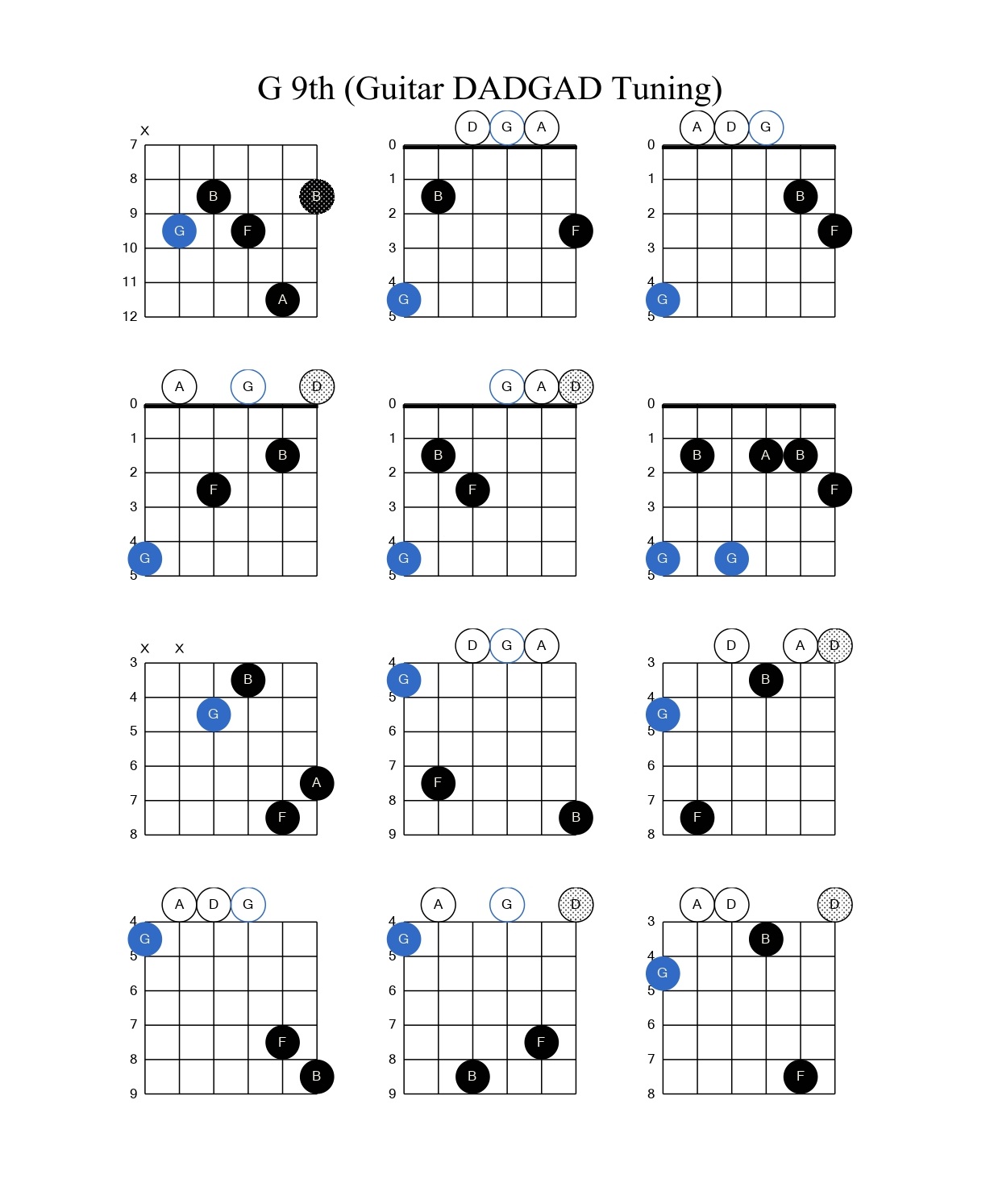Are you looking to add a fresh and unique flavor to your guitar playing? If so, then the G 9th chord in DADGAD tuning might be just what you need. DADGAD is an alternate tuning that offers a wide range of exciting possibilities, and the G 9th chord is a perfect example of its creative potential. In this blog post, we’ll explore the G 9th chord in DADGAD tuning, break it down step by step, and provide you with a handy chord chart for reference.
Understanding DADGAD Tuning:
Before we delve into the G 9th chord, let’s briefly discuss DADGAD tuning. DADGAD is an open tuning that deviates from the traditional EADGBE tuning. In DADGAD, the strings are tuned as follows:
- 1st string (high E): D
- 2nd string (B): A
- 3rd string (G): D
- 4th string (D): G
- 5th string (A): A
- 6th string (low E): D
This unique tuning creates a lush, open sound and is often favored by fingerstyle and acoustic guitarists for its rich harmonic possibilities.
The G 9th Chord in DADGAD Tuning:
Now that we’ve familiarized ourselves with DADGAD tuning, let’s explore the G 9th chord within this context. The G 9th chord in DADGAD tuning can be a bit challenging at first, but with practice, you’ll master it in no time.
Here’s a step-by-step guide on how to play the G 9th chord in DADGAD tuning:
- Place your index finger on the 5th fret of the 1st (high D) string.
- Press down your ring finger on the 7th fret of the 2nd (A) string.
- Position your middle finger on the 7th fret of the 3rd (D) string.
- Press your pinky finger on the 7th fret of the 4th (G) string.
- Leave the 5th (A) and 6th (low D) strings open.
Chord Chart:
To help you visualize the G 9th chord in DADGAD tuning, here’s a chord chart:
e|---5---|
B|---7---|
G|---7---|
D|---7---|
A|---5---|
D|-------|
Practice Tips:
- Start by fretting each note individually to ensure a clean sound.
- Work on your finger strength and dexterity to make the chord changes smoother.
- Experiment with strumming patterns and fingerpicking to explore the chord’s tonal possibilities.
- Use this chord as a basis for creating your own compositions or adapting existing songs to DADGAD tuning.
The G 9th chord in DADGAD tuning is a fascinating addition to your guitar repertoire. Its unique sound and the open tuning of DADGAD provide a canvas for creativity and exploration. By mastering this chord and experimenting with it in your playing, you can unlock new sonic landscapes and take your guitar skills to the next level. So grab your guitar, tune it to DADGAD, and let the journey of discovering the G 9th chord begin. Happy playing!
Variations of the G 9th Chord:
- Gmaj9: This variation adds a touch of major flavor to the G 9th chord. To play it in DADGAD tuning, place your index finger on the 5th fret of the 1st (high D) string and bar the 7th fret with your ring finger across the 2nd (A), 3rd (D), and 4th (G) strings. Leave the 5th (A) and 6th (low D) strings open.
- G9sus4: Create a suspended feel by lifting your ring finger off the 2nd (A) string while keeping the rest of the G 9th chord shape intact.
- G9add6: Add a hint of sweetness by including the 9th note (the 7th fret of the 5th A string) and 6th note (the 5th fret of the 6th low D string) in the chord shape.
Songs Featuring the G 9th Chord:
- Led Zeppelin – “Kashmir”: The iconic riff in this song is played using DADGAD tuning and incorporates variations of the G 9th chord.
- Nick Drake – “Cello Song”: Nick Drake’s fingerstyle masterpiece uses DADGAD tuning and features the G 9th chord.
- Jimmy Page – “White Summer / Black Mountain Side”: Another Led Zeppelin classic in DADGAD tuning, showcasing the G 9th chord in various parts of the song.
Using the G 9th Chord in Your Own Music:
The G 9th chord can bring a unique, rich sound to your compositions. Here are some creative ideas for incorporating it into your music:
- Chord Progressions: Experiment with G 9th in your chord progressions. It pairs well with other chords in DADGAD tuning like Dmaj7 and Asus4.
- Riffs and Melodies: Create catchy riffs and melodies using the G 9th chord shape. The open tuning allows you to explore various voicings and inversions.
- Instrumental Breaks: Use the G 9th chord for instrumental breaks or as a transition in your songs to add a distinct character.
- Dynamic Strumming: Develop dynamic strumming patterns to emphasize the chord’s unique tonal qualities.
Remember, mastering the G 9th chord in DADGAD tuning takes time and practice, but the rewards are well worth it. It can open up new avenues for your guitar playing and songwriting, giving your music a fresh, captivating sound.
Incorporate these variations, study songs that utilize the G 9th chord, and let your creativity flow. With dedication and exploration, you’ll find endless opportunities to create beautiful, unique music with the G 9th chord in DADGAD tuning. Happy playing and composing!
- Get Faster Fingers on Guitar in one week with chord Chart
- 3 Easy Guitar Songs with 3 Easy Chords
- Guitar Beginners should be Know The Lesson about Jazz Guitar Chords
- A Comprehensive PDF Guide for Beginners – Guitar Chord Book + 296 Songs

2 thoughts on “Mastering the G 9th Chord in DADGAD Tuning: A Comprehensive Guide with Chord Chart”